
Healthcare professionals must be able to handle complex medical scenarios whilst ensuring practices that are based on the state of the art and are adapted to the specific patient in the specific situation. This involves the interaction between people from different professions and occupational groups. The ability to adapt to changes is increasingly important in healthcare. Based on this, simulation is a focus area at the Faculty of Health Sciences at the University of Stavanger (UiS), both in education and research. Great emphasis is placed on simulation as a learning method in our health educations, closely linked to digital tools, and multi-professional collaboration.
In key reports, the World Health Organization (WHO) emphasizes multi-professional education and training as important for patient safety. Two reports are especially relevant: “Framework of Action on IPE & Collaborative Practice”(1) and “Patient Safety Curriculum Guide: Multi-Professional Curriculum Guide”(2). Both frameworks intend to strengthen successful team education and training. The background for this focus has been the increasing specialization in healthcare that has resulted in a fragmented service and the need to learn around multi-professional collaboration. Consequently, the reports emphasize the value of multi-professional education and cooperation to improve the health offers – within hospitals, but also across the different healthcare sectors.
Since 2013 a mandatory multi-professional simulation day has been introduced at UiS and Stavanger University Hospital (SUS). This is an arena where nursing students, doctors and ambulance personnel meet for multi-professional simulation. Throughout the simulation days, students are helped by trained nurses and doctors to work through various scenarios. The emphasis of these trainings is on interdisciplinary communication and collaboration. The training takes place at the nursing laboratory at UiS or at the simulation and learning center SAFER, operated by SUS, UiS, and Laerdal Medical.
When healthcare workers with different backgrounds and different education meet, they can learn how to recognize and use their complementing skills for solving problems and implementing solutions. Increasingly the group dynamics comes into the focus, issues of conflict management, supporting team members in difficult decisions, balancing the need to treat the patient quickly and to arrange for an interesting mix of tasks. This way a group can go beyond the individual possibilities in terms of treatment and also in creating more attractive conditions to work in. Considering the challenges for recruiting and keeping workforce, this perspective is increasingly important. International research shows that patient injuries are often due to poor communication, which in turn, can – at times – be related to challenges in group dynamics. Training must get more attention in education as a mandatory part of the teaching. The education should also have more focus on multi-professional training, and the student’s communication skills should be improved. Training together gives an understanding of the role of other occupational groups. It builds respect and loyalty, which in turn provides increased safety for the patient, says researcher and associate professor Ingunn Aase at UiS(3).
Written by Nina Vatland, Camilla Nordmann, Peter Dieckmann, Une Stømer and Thor Ole Gulsrud from the University of Stavanger
References:
- Organization WH. Framework for action on interprofessional education and collaborative practice. World Health Organization; 2010.
- Safety WP, Organization WH. Patient safety curriculum guide: Multi-professional edition. 2011.
- Aase K. Pasientsikkerhet: teori og praksis: Universitetsforl.; 2018.



